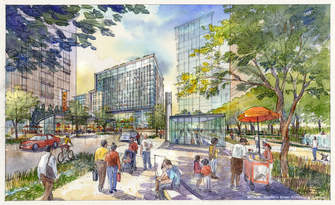Baltimore, MD: $215M State Center Renovation Approved
 The Board of Public Works on Wednesday unanimously green-lighted work to begin on the $215 million first phase of a massive public-private partnership designed to revitalize central Baltimore, improve government office space, and create jobs.
The Board of Public Works on Wednesday unanimously green-lighted work to begin on the $215 million first phase of a massive public-private partnership designed to revitalize central Baltimore, improve government office space, and create jobs.
The revitalization of State Center project will give a boost to the ailing construction industry at a time when commercial development is hurting, and will cost state taxpayers little because of low interest rates and the risks borne by private developers.
Planning for the 28-acre area of outdated office buildings and surface parking lots next to Bolton Hill dates back to when Gov. Martin O’Malley, now chair of the Board of Public Works, was mayor of Baltimore.
The five-phase project, currently estimated at $1.5 billion, has officially been underway for about a year, when the board approved the project’s master development plan. Wednesday’s vote approved long-term state leases for the office buildings and garage that are part of the project, which establishes much of the financial security for work to begin.
Michael Gaines Sr., assistant secretary for real estate at the Department of General Services, said construction work on the first phase of the project is slated to begin in the fall.
Projections indicate that the revitalization project will bring thousands of new jobs and millions in new revenues to the state. The revitalization area is bound by Martin Luther King Jr. Boulevard, Howard Street, Hoffman Street and Madison Avenue. It is planned as a mixed-use development, combining state offices, private business offices, stores, housing, public transportation, parking, and open space – replacing the aging state government office buildings there now.
“This will be a vibrant, reconnecting, safe, walkable community,” said Caroline Moore, Chief Executive Officer of Ekistics, LLC, the managing partner of the project’s private development team.
The first phase of the project includes two new office buildings and a 930-space parking garage. The state will lease 500,000 square feet of the new space for offices of the Department of Health and Mental Hygiene, the Department of Planning and the Maryland Transit Administration. Some office space will be available for the private sector. Additionally, 70,000 square feet will be used for retail outlets, including a grocery store in an area that lacks one. Officials say that Phase 1 of the project will support 1,200 construction jobs and 800 new permanent jobs.
State Treasurer Nancy Kopp said that the current buildings in State Center, which house 3,500 state employees, are substandard and have needed replacement.
“It had to be done,” Kopp said. “The question was how can we afford it? How can we do it?”
The answer was for the private and public sectors to join together. Public-private partnerships take many forms, but generally use a negotiated combination of public and private funds and resources to get a project funded and operated. If everything works out as planned in the agreements, both the public and private sectors benefit from the investment.
This public-private partnership deal was negotiated over three “intense and fun” years, Gaines said. Christopher Patusky, the director of the Department of Transportation’s Real Estate Office, said that while in the negotiation phase, the state retained national real estate consulting firms Jones Lang LaSalle and Bay Area Economics to ensure that Maryland was going to reap the biggest benefits from the agreement.
Most of the funding is coming from the private sector — $151 million in debt, and $36 million in equity, Gaines said. The state is carrying the $28 million cost to build the garage.
To balance the agreement, the state will lease much of the office space for 20 years. The first five years of these leases were approved on Wednesday, adding up to about $18 million. The rent is calculated at a base of $25.85 per square foot, Gaines and Patusky said, and will end up costing about $34 per square foot when management costs are added. The leases begin in 2014, when the buildings are finished.
Gaines said that with the influx of taxes generated by the new jobs and economic activity, the government should easily earn back its investment.
The private development cost is split between three groups, including large national urban developers and local Maryland businesses, Gaines said.
There is no guarantee that the private investors will profit from the agreement, Gaines said, but the state’s financial reputation helped seal the deal.
Comptroller Peter Franchot grilled project officials, saying that the project concept had already been approved, but he was “a little concerned about a project like this in the midst of an economic downturn.”
Moore and Gaines said the recession has driven labor costs down, as well as helped the state obtain a lower interest rate on its bonds, making this an especially opportune time to begin the project.
“This project is benefitting by the misery of the marketplace,” Moore said.
Originally posted by Maryland Reporter: Public-private $215 million State Center revitalization gets go ahead